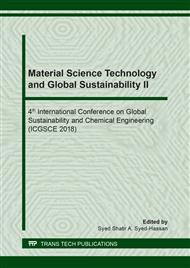[1]
P. Chetpattananondh, Overview of the agarwood oil industry, in International Federation of Essential Oils and Aroma Trades (IFEAT), 2012, p.131–138.
Google Scholar
[2]
Y. Z. H. Y. Hashim, N. I. Ismail, and P. Abbas, Analysis of Chemical Compounds of Agarwood Oil From Different Species By Gas Chromatography Mass Spectrometry ( GCMS), Int. Islam. Univ. Malaysia Eng. J. 15 (2014) 55–60.
DOI: 10.31436/iiumej.v15i1.469
Google Scholar
[3]
S. N. Tajuddin, N. S. Muhamad, M. A. Yarmo, and M. M. Yusoff, Characterization of the chemical constituents of agarwood oils from Malaysia by comprehensive two dimensional gas chromatography–time-of-flight mass spectrometry, Mendeleev Commun. 23 (2013) 51–52.
DOI: 10.1016/j.mencom.2013.01.019
Google Scholar
[4]
T. W. Lim and A. A. Noorainie, Wood for the Trees: a review of the agarwood (gaharu) trade in Malaysia, Petaling Jaya, (2010).
Google Scholar
[5]
S. A. Chime, F. C. Kenechukwu, and A. A. Attama, Nanoemulsions -Advances in Formulation , Characterization and Applications in Drug Delivery, in Application of Nanotechnology in Drug delivery, A. D. Sezer, (Ed.), InTech, Rijeka, 2014, p.552.
DOI: 10.5772/58673
Google Scholar
[6]
M. I. Briceno, J. L. Salager, and C. L. Bracho, Heavy Hydrocarbon Emulsions Making Use of the State of the Art in Formulation Engineering, in Encyclopedic Handbook of Emulsion Technology, J. Sjöblom, (Ed.), CRC Press, New York, 2001, p.455–495.
DOI: 10.1201/9781420029581.ch20
Google Scholar
[7]
Y. T. Boon et al., Grading of Emulsified Agarwood Oil Using Gel Electrophoresis Technique, Eng. Technol. Int. J. Chem. Mol. Eng. 10 (2016) 547–551.
Google Scholar
[8]
T. G. Mason, J. N. Wilking, K. Meleson, C. B. Chang, and S. M. Graves, Nanoemulsions: formation, structure, and physical properties, J. Phys. Condens. Matter, 18 (2006) R635–R666.
DOI: 10.1088/0953-8984/18/41/r01
Google Scholar
[9]
V. Vaclavik and E. W. Christian, Essentials of Food Science, (4th ed.), Springer, New York, (2014).
Google Scholar
[10]
T. F. Tadros, A. Vandamme, B. Levecke, K. Booten, and C. V. Stevens, Stabilization of emulsions using polymeric surfactants based on inulin. Adv Colloid Interface Sci. 20 (2004) 207–226.
DOI: 10.1016/j.cis.2003.10.024
Google Scholar
[11]
P. Taylor and R. H. Ottewill, The formation and ageing rates of oil-in-water miniemulsions, Colloids Surfaces A Physicochem. Eng. Asp. 88 (1994) 303–316.
DOI: 10.1016/0927-7757(94)02853-2
Google Scholar
[12]
P. Izquierdo et al., Phase behavior and nano-emulsion formation by the phase inversion temperature method, Langmuir 20 (2004) 6594–6598.
DOI: 10.1021/la049566h
Google Scholar
[13]
E. S. Mahdi, M. H. F. Sakeena, M. F. Abdulkarim, G. Z. Abdullah, M. A. Sattar, and A. M. Noor, Effect of surfactant and surfactant blends on pseudoternary phase diagram behavior of newly synthesized palm kernel oil esters, Drug Des. Devel. Ther. 5 (2011) 311–323.
DOI: 10.2147/dddt.s15698
Google Scholar
[14]
V. Ghosh, A. Mukherjee, and N. Chandrasekaran, Eugenol-loaded antimicrobial nanoemulsion preserves fruit juice against, microbial spoilage, Colloids Surfaces B Biointerfaces 114 (2014) 392–397.
DOI: 10.1016/j.colsurfb.2013.10.034
Google Scholar
[15]
J. S. Taurozzi, V. A. Hackley, and M. R. Wiesner, Protocol for Preparation of Nanoparticle Dispersions From Powdered Material Using Ultrasonic Disruption, Version 1.11. NIST special publication 1200-2, Gaithersburg, MD, 2010, p.14.
DOI: 10.6028/nist.sp.1200-2
Google Scholar
[16]
A. Dinda, I. Biswal, P. Chowdhury, and R. Mohapatra, Formulation development and evaluation of paclitaxel loaded solid lipid nanoparticles using glyceryl monostearate, J. Appl. Pharm. Sci. 3 (2013) 133–138.
Google Scholar
[17]
A. Bera, A. Mandal, and B. B. Guha, Synergistic effect of surfactant and salt mixture on interfacial tension reduction between crude oil and water in enhanced oil recovery, J. Chem. Eng. Data 59 (2014) 89–96.
DOI: 10.1021/je400850c
Google Scholar
[18]
S. Da Costa, M. Basri, N. Shamsudin, and H. Basri, Stability of Positively Charged Nanoemulsion Formulation Containing Steroidal Drug for Effective Transdermal Application, J. Chem. (2014) 1–8.
DOI: 10.1155/2014/748680
Google Scholar
[19]
M. Herrera, Analytical Techniques for Studying the Physical Properties of Lipid Emulsions, Springer, New York, (2012).
Google Scholar
[20]
T. Helgason, T. S. Awad, K. Kristbergsson, D. J. McClements, J. Weiss, Effect of surfactant surface coverage on formation of solid lipid nanoparticles (SLN), J. Colloid Interf. Sci. 334 (2009) 75-81.
DOI: 10.1016/j.jcis.2009.03.012
Google Scholar
[21]
M. J. Rosen and J. T. Kunjappu, Surfactants and Interfacial Phenomena, (4th ed.), John Wiley & Sons, New Jersey, (2012).
Google Scholar
[22]
L. Guo, R. H. Colby, M. Y. Lin, and G. P. Dado, Micellar structure changes in aqueous mixtures of nonionic surfactants, J. Rheol. 45 (2001) 1223-1243.
DOI: 10.1122/1.1389315
Google Scholar
[23]
S. M. Jafari, Y. H. He, and B. Bhandari, Nano-emulsion production by sonication and microfluidization-a comparison, Int. J. Food Prop. 9 (2006) 475–485.
DOI: 10.1080/10942910600596464
Google Scholar
[24]
P. Somasundaran, Encyclopedia of Surface and Colloid Science, Vol 2., CRC Press, New York, (2006).
Google Scholar
[25]
L. A. Lewis, Cyanoacrylate Fuming Method, in Lee and Gaensslen's Advances in Fingerprint Technology, (3rd ed.), R. Ramotowski, (Ed.), CRC Press, New York, 2010, p.263.
Google Scholar
[26]
B. White, S. Banerjee, S. O'Brien, N. J. Turro, and I. P. Herman, Zeta-potential measurements of surfactant-wrapped individual single-walled carbon nanotubes, J. Phys. Chem. C, 111 (2007) 13684–13690.
DOI: 10.1021/jp070853e
Google Scholar
[27]
R. J. Smith, M. Lotya, and J. N. Coleman, The importance of repulsive potential barriers for the dispersion of graphene using surfactants, New J. Phys. 12 (2010) 11.
DOI: 10.1088/1367-2630/12/12/125008
Google Scholar
[28]
K. M. Wasan, Role of lipid excipients in modifying oral and parenteral drug delivery: basic principles and biological examples, John Wiley & Sons, New Jersey, (2006).
DOI: 10.1002/0470097981
Google Scholar
[29]
J. M. de Morais, O. D. H. dos Santos, T. Delicato, and P. A. da Rocha-Filho, Characterization and evaluation of electrolyte influence on canola oil/water nano-emulsion, J. Dispers. Sci. Technol. 27 (2006) 1009–1014.
DOI: 10.1080/01932690600767056
Google Scholar
[30]
R. H. Müller, Colloidal Carriers for Controlled Drug Delivery and Targeting: Modification, Characterization and in Vivo Distribution, CRC Press, Boca Raton, (1991).
Google Scholar


